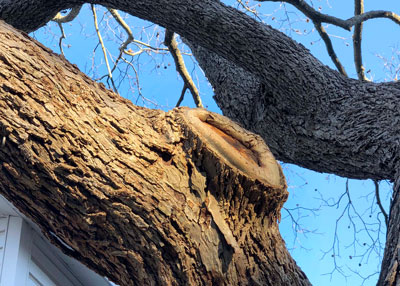Great Example of a “Branch Collar”
We have a very large pecan that towers over our house from its home near our front door. One particular branch, through its own weight, had lowered to a point where it was about to start rubbing the roof. I asked the crew from Arborilogical Services to remove it five years ago while they were doing their routine annual maintenance of the trees in our landscape.

Owner and former Texas Arborist of the Year, my friend Steve Houser mentioned to me that they would be leaving a significant amount of the branch collar to aid in the limb’s healing across the cut surface. Having had his crews working on our trees for more than 20 years, I knew to trust his decisions.
As I looked up at our tree this past weekend I realized how well it demonstrates what a “branch collar” is. I try to tell people that it’s like the delta of a river where it enters a lake or the sea – it’s where it widens as it enters the larger body of water.

By trimming branches to leave a short section of branch collar you allow the tree’s tissues to form a roll of new bark uniformly around the cut. Your goal is that the roll will meet itself in the middle of the wound, sealing off the internal tissues to outside invaders. Perfect pruning results in a perfectly symmetrical donut of bark and a healed wound that is almost impossible to see.
Our pecan is heading that direction. With a little luck it will be there in just a few more years. Stay tuned. I’ll report back when that happens.
